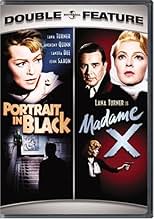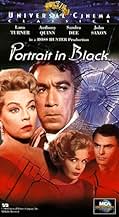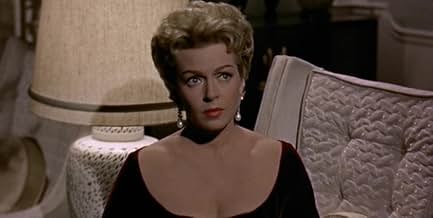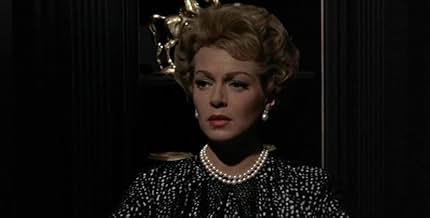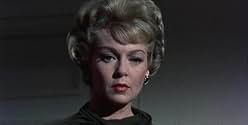After repressed wealthy Sheila Cabot and her physician lover Dr. David Rivera murder her cruel invalid husband Matthew, they are targeted by someone who is aware of their crime.After repressed wealthy Sheila Cabot and her physician lover Dr. David Rivera murder her cruel invalid husband Matthew, they are targeted by someone who is aware of their crime.After repressed wealthy Sheila Cabot and her physician lover Dr. David Rivera murder her cruel invalid husband Matthew, they are targeted by someone who is aware of their crime.
Featured reviews
That's the setup for this melodrama-mystery combo, a story that involves passion, suspicion, deception, and ultimately murder. The film's easy to follow plot gets a needed boost when a card addressed to Sheila arrives in the mail. All the card says is: "Congratulations on the success of ..." That scene sends the plot hurling into mystery territory. Who wrote the card, and why?
The script's two main characters behave in ways that do not seem credible, given their circumstances. And the idea that a grown woman living in California has never learned to drive is a tad dubious.
The film's overall look and feel is that of a typical 1950s melodrama. Elegant, expensive clothes, dreamy violin background music, and melodramatic acting conjure up visions of some sudsy 1950s film directed by Douglas Sirk. I don't recall any scene in which Lana Turner is not wearing an expensive dress and, in some scenes, a full-length mink coat.
Color cinematography is acceptable, if unremarkable. Casting favors well-known actors. And they perform well enough. I was pleasantly surprised by the performance of Sandra Dee.
If you're looking for a believable story, look elsewhere. If you're looking for a sudsy melodrama and/or mystery, "Portrait In Black" will appeal. I could have done without the pretentious suds of these very rich people. But the plot puzzle provided enough mystery to keep me hooked.
In a beautifully drippy, bleeding, sticky Douglas Sirk mode, and one year after leading lady Lana Turner appeared in Sirk's "Imitation of Life," this highly slick and artificial (and yet moving) melodrama is one of the high points in a low period of Hollywood. The other main character is Anthony Quinn, who is remarkable, too, one of those underrated leading men, I'm not sure why. The two of them are supported by Richard Basehart as a fascinating and chilling underling with a peculiar mysterious cheerfulness, and Sandra Dee, who plays the spoiled daughter all too well (as you can imagine).
Unlike Sirk's dramas, this one, directed by is not just about normal human dramas (soap opera stuff), but adds a criminal and suspense element that kicks in after half an hour. The throbbing music takes on a different meaning here, and the sobbing and regrets make for an intense ride.
The deeper you get into this movie, the deeper the plot gets, with intrigue and worry and more murder mounting. And it's all filmed with fluid, rich, widescreen color photography, with intensely rendered music (that holds nothing back), and with a subtle kind of attention to nuance that oddly adds to the excesses of the plot.
And it's the plot, the story, that is so finely tuned it sustains all this cinematic swaying. It's not like some movies where the music or the photography drives the plot--here they are woven together really well, artfully and emphatically. Quinn and Turner are both extraordinary, lifting what could have been a soap opera to something completely fuller.
Russell Metty, behind the camera, was at the peak of his career, having shot not only "Imitation of Life" the year before but Sirk's early "Written on the Wind" (and moving on quickly to several masterpieces like "Spartacus" and "The Misfits"). And in fact the composer, veteran Frank Skinner, wrote the music for those two classic Sirk films, as well. It's worth stressing all this because Sirk has a huge (and deserved) following, and I have a feeling this one is just under the radar of Sirk fans. If a great Sirk film seems to almost reference itself the way it becomes so perfectly "arch" in its stereotypes, "Portrait in Black" does maintain a sense of being still a film wanting to move a plot idea along (these are subtle differences about style becoming affectation on purpose). But even so, the parallels are extraordinary, and this is a remarkable movie on those terms.
It's worth wondering what else, beyond Sirk, was going on around this time, and in fact, with the murder and suspense here it helps to look at Hitchcock's films "North by Northwest" (1959) and "Vertigo" (1958). Both are clearly influences in filming style, lacking only that higher level of stylized artfulness (and storytelling) that Hitch was by then such a master of. Or then, you might say, there was perhaps the influence of Sirk on Hitchcock, at least in the visual richness and fluidity (something Hitch abandoned immediately, almost making a point, this very year with "Psycho").
Anyway, if you don't mind an over the top melodrama done to perfection, here you go. And for movie fans, check out Anna May Wong's last film appearance (not a great performance, but she's her own legend). See it on the biggest screen you can, too--this doesn't translate well at all to a laptop experience.
Lana is having an affair with Anthony Quinn, the doctor who is attending her terminally ill husband, Lloyd Nolan, a shipping magnate. Nolan's company, Cabot Lines, is evidently quite successful, because Lana's daily expenditures on wardrobe, coiffures, and makeup would likely sink a ship. The couple's palatial San Francisco home is a Ross Hunter fantasy whose upkeep could sink yet another Cabot Line vessel. Nolan's daughter from a first marriage, Sandra Dee, evidently has her stepmother's taste in clothes and manicure, while the son from his marriage to Lana has to make do with a toy airplane. Throw in a greedy business associate played by Richard Basehart; Dee's suitor, John Saxon; a chauffeur, Ray Walston; and a housekeeper, Anna May Wong; and you have a delicious cast of potential suspects to populate an Agatha Christie mystery. However, "Portrait in Black" is not a whodunit, but rather a "who knows they dun it."
Lana is the ultimate drama queen, and she is in peak form. She suffers, she screams, she cries; she is the empress of high camp. Anthony Quinn, who should have read the script before he signed the contract, plays down to his part and seems to know he has had and will have better parts. Sandra Dee appears to be studying for future Lana Turner roles, while Walston and Wong play their parts with the necessary ambiguity to keep viewers guessing their secrets.
However, despite the overacting, bad writing, and soap opera direction, "Portrait in Black" is great fun for those who love their melodramas with big budgets and great style. Even the obligatory mirror smashing has been incorporated. The movie is enormously entertaining for its sometimes howlingly funny situations, absurd lines, and the sheer pleasure of watching Lana looking and emoting at her best.
Did you know
- TriviaFinal film of Anna May Wong.
- GoofsAlthough Mason is shown driving a 1959 Dodge Custom Royal Lancer, the car that goes over the cliff is a less expensive 1958 Dodge Coronet Lancer. And, when it goes over the cliff, extensive front-end damage can be seen, meaning this was probably a wrecked car the studio purchased just for this scene.
- Quotes
Sheila Cabot: Oh don't leave me David, please don't go away!
Dr. David Rivera: I've got to go!
Sheila Cabot: But why Darling, why? I don't know what I'll do if you go!
Dr. David Rivera: I'm - I'm afraid of what I'll do if I stay!
- ConnectionsEdited into The Green Fog (2017)
Details
- Release date
- Country of origin
- Language
- Also known as
- Portrait in Black
- Filming locations
- San Francisco, California, USA(sequence at Devil's Slide on the Pacific Coast Highway - State Route 1)
- Production company
- See more company credits at IMDbPro
Box office
- Budget
- $1,400,000 (estimated)
- Runtime
- 1h 52m(112 min)



